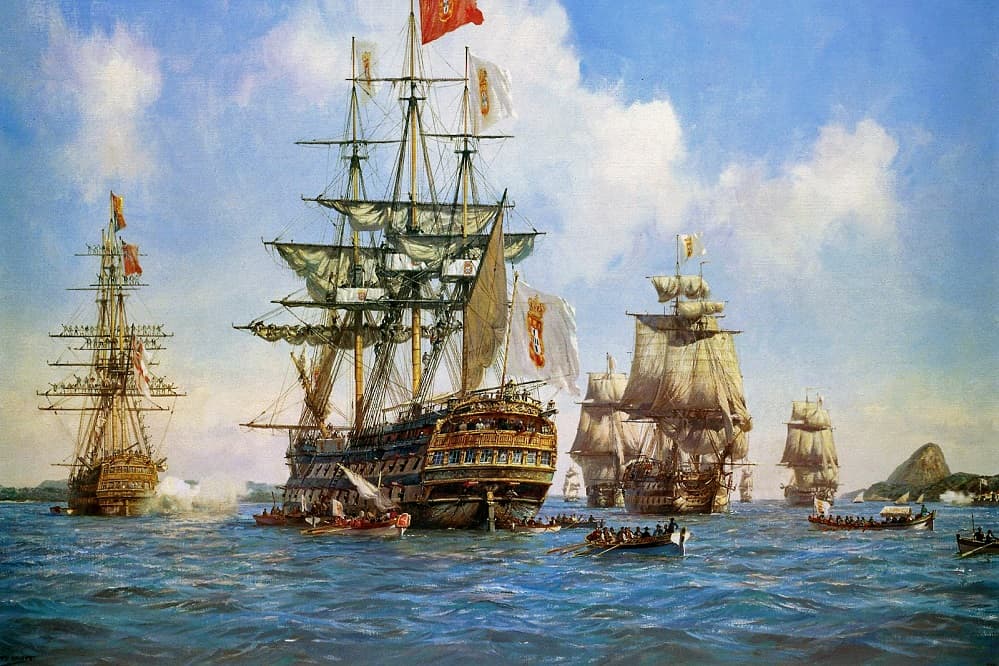
It’s not every day that a dictatorship collapses… in a festive atmosphere filled with red bouquets ! And yet, Portugal pulled off that miracle. On April 25th, 1974, while Europe was quietly waking up, Lisbon was vibrating to the sound of a song Grândola, Vila Morena and the scent of a symbol that would become immortal : the red carnation.
But before we get to that iconic image, armed soldiers with carnations in their rifles, smiles, tears, and a crowd finally daring to breathe, we need to rewind a little…
The context : a country out of breath
At the time, Portugal was still under the dictatorship of the Estado Novo, established by Salazar (and carried on by his successor, Marcelo Caetano). It was an authoritarian regime, frozen in time, that kept the country under constant surveillance : no freedom of expression, an omnipresent political police (the feared PIDE), endless colonial wars in Africa, and an economy… well, exhausted.
The Portuguese youth, especially the soldiers sent to fight in colonies like Angola and Mozambique, had had enough. And, as history often shows, when the people can’t speak, the soldiers eventually do.
April 24th, 10:55 p.m. : the song that started it all
The beauty of this revolution is that it began with… music. (Yes, seriously ! No tanks, no gunfire, just a song on the radio.) The signal for the coup wasn’t a coded message à la James Bond, but two songs broadcast on the radio. First, E Depois do Adeus, at 10:55 p.m. a perfectly ordinary pop song, chosen because it wouldn’t raise the censors’ suspicions. Then, at 12:20 a.m., Grândola, Vila Morena, by Zeca Afonso, a banned song symbolizing fraternity and equality. When that second song played on Radio Renascença, it was the go signal : the military moved out. (Let’s admit it, way more poetic than a “mission launched” message on WhatsApp !)
Dawn, April 25th : Lisbon awakens
The tanks rolled into the capital, but unlike so many other revolutions, this one… had no gunfire, no chaos. Civilians joined the soldiers, cheering, singing, crying. And that’s when Céleste Caeiro entered the scene, the woman of the carnation.
She worked at a restaurant that was supposed to hand out flowers that day to celebrate its anniversary. But because of the unfolding events, the restaurant was closed. So, with her arms full of red carnations, Céleste crossed paths with the soldiers and spontaneously offered them the flowers in support. They placed them in their rifles. And just like that ! In a few minutes, the revolution found its symbol : gentleness standing up to power, freedom that doesn’t kill, it blooms. (And honestly, who would have guessed a bunch of carnations would become more famous than a tank ?)

A revolution without bloodshed
It’s often called “the most peaceful revolution of the 20th century”. Yes, there were a few clashes, but nothing like the usual violence of uprisings. Within a few hours, Marcelo Caetano’s government had fallen. The dictatorship was over. The people flooded the streets, the squares, the balconies. Lisbon turned into a party. People embraced, sang, danced. Carnations were handed out like hope. And it was beautiful, because everything that had been forbidden, talking, dreaming, singing was suddenly reborn !
After the revolution : freedom, chaos and rebuilding
The months that followed weren’t easy (freedom, as it turns out, comes with a price !). The country had to reinvent itself : a new Constitution, the end of the colonial wars, the independence of former colonies, and the first steps of a still fragile democracy. But Portugal made it through with patience and courage. And above all, with a deep conviction engraved in its identity : freedom can bloom even after forty years of political winter.
Why this story still feels magical today
Because April 25th isn’t just a date, it’s a lesson in humanity. A reminder that gentleness can defeat fear, that music can free a people, and that a single gesture, a woman handing a flower to a soldier can change the course of history.
Every year in Portugal, this day is celebrated with concerts, parades, speeches, and of course… red carnations. On jackets, in hair, in the streets. So if you ever find yourself in Lisbon on April 25th, look around : people smile a little wider, sing a little louder, and in the air floats that unmistakable scent of freedom.
And think of Céleste, the waitress who turned a day of revolution into a celebration of the heart !
Share this article
Suggested articles

The Portuguese Colonial Empire, greatness and the end of an era
It is astonishing to think that a small country on the edge of Europe once ruled the seas and shaped global history. In the fifteenth century, Portugal, with barely over a million people, became the beating heart of the Age of Discovery. It was the age of sailors, dreamers and merchants who turned the unknown into possibility.

Amália Rodrigues, the diva who made fado shine across the world
Some artists do not just sing; they embody emotion, history and identity. Amália Rodrigues was one of those rare souls. Born in 1920 in Lisbon’s Mouraria district, she grew up among street vendors, laughter and hardship. There, she discovered fado, the music of love, loss and longing.

António de Oliveira Salazar and the Estado Novo : Shadows and Legacies of a Dictatorship
When I think back to my parents’ stories, leaving Portugal for France at the end of the 1960s, I see in them the reflection of an entire country that took to the road. Their departure wasn’t just a “change of scenery” : it was a flight, a gamble, a hope. And behind that decision lay the weight of Salazar’s long dictatorship, a regime that shaped Portugal for nearly forty years. (And to think that Portugal has only been “free” for about 50 years… yes, it really wasn’t that long ago !)

The Lisbon Earthquake of 1755 : an event that shook Europe
On November 1st, 1755 (All Saints’ Day), the city of Lisbon woke up to the sound of church bells, the faithful filled the pews… and suddenly, the ground began to shake. Around 9:40 a.m., an earthquake with an estimated magnitude between 8.5 and 9.0 struck the city, followed by a devastating tsunami and massive fires that tore through its neighborhoods… You’ve probably heard of it, right ?

The Age of Discovery : how the Portuguese changed the map of the world
Picture this : it’s the late 14th century. A small country on the edge of the Atlantic, sails in the wind, a few daring sailors, and one big dream to discover what lies beyond the horizon ! That’s how the incredible adventure of the Age of Discovery begins, with Portugal taking center stage. And no, it wasn’t just about sketching maps it was a full-on world revolution… and, let’s be honest, a massive “let’s go and see what happens” gamble (spoiler : it paid off).


